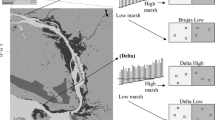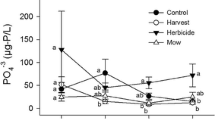Abstract
Mechanical harvesting is used to control submerged aquatic weeds in parts of the hydro-lakes in New Zealand's North Island. Problem species are Egeria densa and Lagarosiphon major (Hydrocharitaceae), and Ceratophyllum demersum. Experiments were conducted in two contrasting hydro-lakes. Lake Aratiatia; clear water (K o 0.2 m−1) and a low residence time (< 8 h), and Lake Ohakuri; turbid water (K o = 0.6) and a longer residence time (> 5 days). Growth rates were measured underwater in harvested and control (unharvested) plots. Regrowth of C. demersum was dependent on the prior establishment of the rooted Hydrocharitaceae. Regrowth of the Hydrocharitaceae was inhibited where significant water movement occurred. Regrowth declined after 3 six-monthly harvests allowing the establishment of low growing native Nitella spp. beds in the smaller clear water lake. In Lake Ohakuri there was a change in species dominance from Ceratophyllum to Elodea canadensis in shallow (1–2 m) water. No change in species dominance was observed in deeper (>2 m) water and native species were not able to re-establish. The recommended cutting frequency for management of surface weed growths was only once per year in Lake Aratiatia, but twice per year in Lake Ohakuri.
Similar content being viewed by others
References
Dawson, F. H. & W. N. Robinson, 1985. Submerged macrophytes and the hydraulic roughness of a lowland chalkstream. Verb. int. Verein. Limnol. 22: 1944–8.
Engel, S. & S. A. Nichols, 1984. Lake sediment alteration for macrophyte control. J. Aquatic Plant Mgmt 22: 38–41.
Henriques, P. R., 1987. Aquatic macrophytes. In P. R Henriques (ed.), Aquatic biology and hydro-electric power development in New Zealand, Oxford University Press, Oxford, 280 pp.
Howard-Williams, C., 1993. Processes of aquatic weed invasions: The New Zealand example. J. Aquat. Plant Mgmt, 31: 17–23.
Johnstone, I. M., 1981. Management strategies for aquatic weeds in hydro-lakes, In The Waters of the Waikato Vol 1. University of Waikato, Hamilton, New Zealand: 35–38.
Nichols, S. A., R. C. Lathrop & S. R. Carpenter, 1992. Long-term vegetation trends: A history. In J. F. Kitchell (ed.), Food web management, A case study of Lake Mendota, Academic Press, NY, 553 pp.
Pitlo, R. H. & F. H. Dawson, 1990. Flow-resistance of aquatic weeds In A. H. Pieterse & K. J. Murphy (eds), Aquatic weeds, The ecology and management of nuisance aquatic vegetation. Oxford University Press, Oxford. 593 pp.
Wade, P. M., 1990. Physical control of aquatic weeds In A. H. Pieterse & K. J. Murphy (eds), Aquatic weeds, The ecology and management of nuisance aquatic vegetation, Oxford University Press, Oxford, 593 pp.
Wade, P. M. & R. W. Edwards, 1980. The effect of channel maintenance on the aquatic macrophytes of the drainage channels of the Monmouthshire levels, South Wales 1840–1976. Aquat. Bot. 8: 307–322.
Author information
Authors and Affiliations
Rights and permissions
About this article
Cite this article
Howard-Williams, C., Schwarz, AM. & Reid, V. Patterns of aquatic weed regrowth following mechanical harvesting in New Zealand hydro-lakes. Hydrobiologia 340, 229–234 (1996). https://doi.org/10.1007/BF00012760
Issue Date:
DOI: https://doi.org/10.1007/BF00012760




